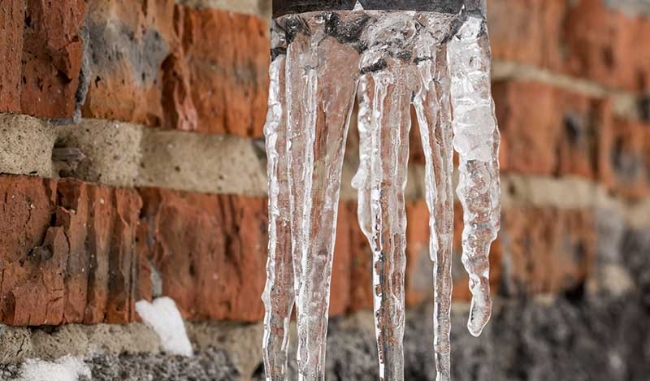Tips to Keep Your Pipes from Cold Weather Issues: Crucial Advice
Tips to Keep Your Pipes from Cold Weather Issues: Crucial Advice
Blog Article
The content directly below about Prevent Frozen Pipes is immensely insightful. Read on and draw your own final thoughts.

Cold weather can damage your plumbing, especially by freezing pipes. Below's how to stop it from taking place and what to do if it does.
Intro
As temperatures decline, the threat of icy pipelines rises, possibly bring about pricey repairs and water damages. Recognizing just how to stop icy pipelines is vital for house owners in chilly climates.
Comprehending Frozen Pipelines
What causes pipelines to freeze?
Pipelines freeze when exposed to temperature levels listed below 32 ° F (0 ° C) for extended periods. As water inside the pipelines ices up, it broadens, taxing the pipeline walls and possibly causing them to rupture.
Threats and damages
Icy pipes can bring about water disruptions, residential or commercial property damage, and pricey repair services. Burst pipelines can flood homes and trigger considerable structural damage.
Indicators of Frozen Pipes
Recognizing icy pipes early can avoid them from breaking.
Exactly how to determine frozen pipelines
Try to find lowered water flow from faucets, uncommon smells or sounds from pipes, and visible frost on subjected pipes.
Prevention Tips
Protecting prone pipelines
Cover pipelines in insulation sleeves or utilize warm tape to secure them from freezing temperatures. Concentrate on pipelines in unheated or external locations of the home.
Heating strategies
Maintain interior rooms appropriately heated up, specifically areas with pipes. Open cupboard doors to permit warm air to flow around pipes under sinks.
Shielding Outside Pipes
Yard pipes and outdoor faucets
Separate and drain garden tubes before winter months. Install frost-proof faucets or cover outdoor faucets with shielded caps.
What to Do If Your Pipes Freeze
Immediate activities to take
If you presume frozen pipelines, keep taps available to relieve pressure as the ice melts. Make use of a hairdryer or towels soaked in hot water to thaw pipelines slowly.
Long-Term Solutions
Structural modifications
Consider rerouting pipelines far from exterior walls or unheated areas. Include additional insulation to attics, basements, and crawl spaces.
Upgrading insulation
Purchase high-grade insulation for pipes, attic rooms, and walls. Appropriate insulation helps keep constant temperature levels and decreases the risk of frozen pipelines.
Final thought
Stopping frozen pipelines calls for aggressive measures and fast responses. By understanding the reasons, signs, and safety nets, property owners can protect their pipes during winter.
6 Proven Ways to Prevent Frozen Pipes and Protect Your Home
Disconnect and Drain Garden Hoses
Before winter arrives, start by disconnecting your garden hoses and draining any remaining water. Close the shut-off valves that supply outdoor hose bibs and leave the outdoor faucet open to allow any residual water to drain. For extra protection, consider using faucet covers throughout the colder months. It’s also important to drain water from any sprinkler supply lines following the manufacturer’s directions.
Insulate Exposed Pipes
Insulating your pipes is an effective way to prevent freezing. Pipe insulation is readily available at home improvement stores and is relatively inexpensive. Pay close attention to pipes in unheated areas such as the attic, basement, crawl spaces, or garage. Apply foam insulation generously to create a buffer against the cold. You can also wrap your pipes in heat tape or thermostat-controlled heat cables for added warmth.
Seal Air Leaks
Inspect your home for any cracks or openings that could let in cold air. Seal any holes around the piping in interior or exterior walls, as well as the sill plates where your home rests on its foundation. Additionally, make sure to keep your garage door closed unless you’re entering or exiting. Leaving it open creates a significant air leak that can lead to frozen pipes.
Allow Warm Air Circulation
During cold snaps, it’s essential to allow warm air to circulate evenly throughout your home. Leave interior doors ajar to promote better airflow. Open kitchen and bathroom cabinets to help distribute heat consistently around the rooms. If you have small children or pets, be sure to remove any household chemicals or potentially harmful cleaners from open cabinets for safety.
Let Faucets Drip
A small trickle of water can make a big difference in preventing ice formation inside your pipes. When temperatures drop significantly, start a drip of water from all faucets served by exposed pipes. This continuous flow helps prevent the water from freezing. Additionally, running a few faucets slightly can relieve pressure inside the pipes, reducing the chances of a rupture if the water inside does freeze.
https://choateshvac.com/6-proven-ways-to-prevent-frozen-pipes-and-protect-your-home/
:strip_icc()/snow-outdoor-faucet-pipes-4af65d1e5e904fb1aa7bf74071fe5d89.jpg)
As a keen person who reads on 6 Ways to Prevent Frozen Pipes, I was thinking sharing that piece was essential. Enjoyed reading our blog? Please share it. Let somebody else find it. Thank you for your time. Return soon.
Click Here Report this page